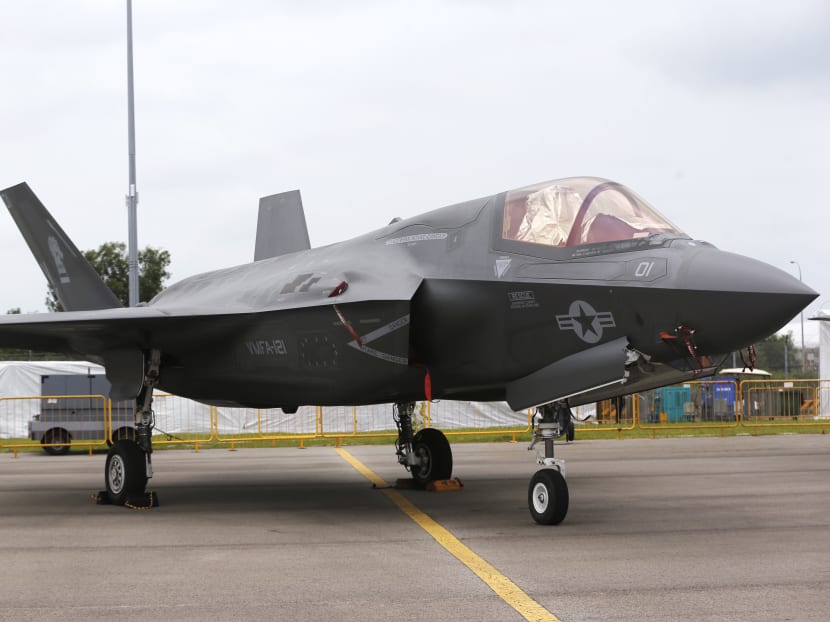Explainer: Why the F-35s have been identified to replace S'pore’s F-16s
SINGAPORE — After evaluating the F-35 Joint Strike Fighter for more than five years, the Ministry of Defence announced on Friday (Jan 18) that the Lockheed Martin jet has been identified as a replacement for its ageing F-16s.
SINGAPORE — After evaluating the F-35 Joint Strike Fighter for more than five years, the Ministry of Defence (Mindef) announced on Friday (Jan 18) that the Lockheed Martin jet has been identified as a replacement for its ageing F-16s.
It was hardly a surprise, as speculation had been rife since as far back as 2013 that the F-35 could be Singapore’s jet of choice.
But why did the authorities take so long to decide on the F-35, given that 13 countries — including Australia, Israel and South Korea — had already chosen it as their next-generation fighter jet?
Read on to find out more about what has been billed as the world’s most advanced combat jet.
ABOUT THE F-35s
They are developed by Lockheed Martin, the United States' top defence contractor.
Reports have suggested that Singapore is particularly interested in buying the F-35B model, which can take off from shorter runways and land like a helicopter.
Last year, Defence Minister Ng Eng Hen told reporters that replacement options for the F-16s included the F-35, Eurofighter Typhoon, Chinese-made stealth fighters, the Russian Sukhois, and 4.5- and fifth-generation stealth fighters.
The evaluation took longer than expected as the Republic of Singapore Air Force (RSAF) and the Defence Science and Technology Agency had to go through specifications and needs in detail, said Dr Ng said in a Facebook post on Friday.
WHY CHOOSE THE F-35?
Mr David Boey, who sits on Mindef’s Advisory Council on Community Relations in Defence, told TODAY: “It is said to be a game-changer, as the warplane makes more extensive use of information for air-to-air and air-to-ground engagements than previous generations of fighters like the F-16.”
For example, the F-35 gives pilots a better sense of threats and targets around the aircraft, by gathering information from its own radar and sensors, and fusing it with data from other platforms.
Its “stealthy design” also makes the F-35 less detectable by radar.
Mr Boey noted that presently, the programme is more amenable to customer modifications. It is important that the RSAF’s F-35 variant is able to exchange data and “talk” to other Singapore Armed Forces’ weapons and sensors.
Mr Mike Yeo, the Asia reporter for the US defence publication Defence News, had these to say:
The F-35s are said to have radar signature reduction measures and sensor fusion that are far more superior to those of the Eurofighter Typhoon or Dassault Rafale. These are relatively older aircrafts (termed “Generation 4+”), having been in service for about 15 years. In comparison, the F-35 is a fifth-generation fighter jet.
If Singapore does buy F-35B models as reports have suggested, it will reduce the RSAF’s need for long runways. It will also be the first time that Singapore operates a stealth aircraft.
DEVELOPMENTS OVER THE PAST FEW MONTHS
Amid concerns and criticism over how expensive the defence programme was, Lockheed Martin agreed to cut prices for all three variants of the F-35s in September last year.
Costs for the F-35A conventional take-off and landing model were cut from US$94.3 million (S$128 million) to US$89.2 million. Those for the F-35B model dropped 5.7 per cent to US$115.5 million.
In December last year, after several months’ delay, the F-35 officially entered its initial operation test and evaluation phase to determine if it performs in combat situations.
That same month, reports emerged of Japan’s plans to buy 100 more F-35s on top of the 42 F-35As it had already ordered.
Earlier this month, the United Kingdom declared that its F-35s are ready for combat, and could take to the skies against Islamic State terrorists in Syria and Iraq by the summer.









